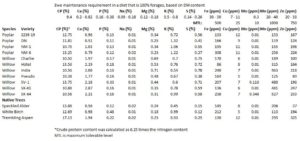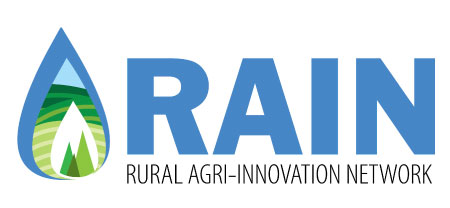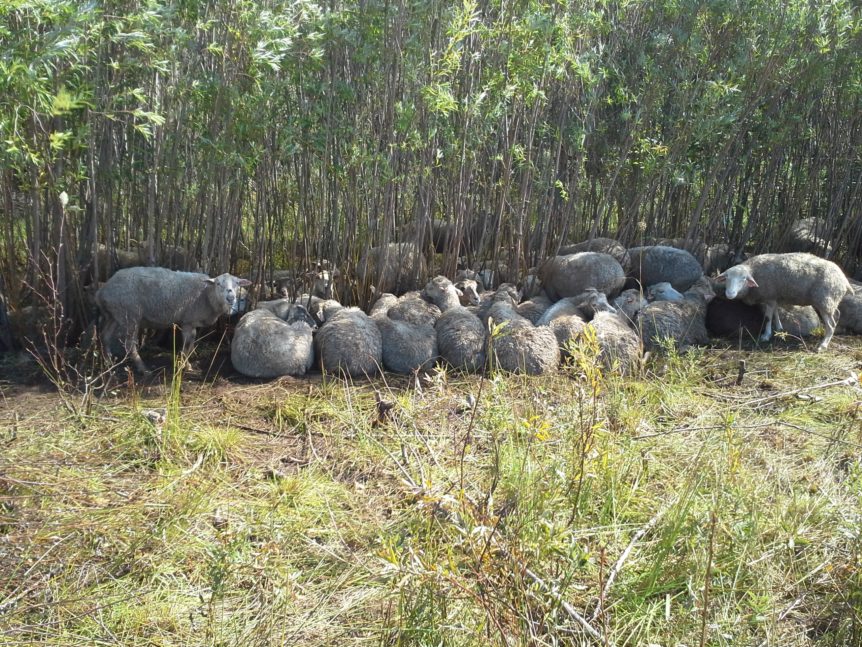This research note is part of a series detailing results from different facets of the trial. For more information, see:
Fodder Trees: 2015 Yield and Nutrient Analysis
2015 Sheep Preferences of Fodder Trees
Economic Analysis and Practical Applications of Fodder Trees
RAIN has partnered with the Ontario Sheep Marketing Agency to investigate whether fast-growing, coppiced trees can be a nutritionally and economically viable fodder source for sheep. This project is taking place over the 2015 and 2016 growing seasons near Sault Ste Marie.
Method
In 2007, a short rotation woody coppice plantation was established by the Canadian Forest Service to assess the potential of fast growing willow and poplar for bioenergy. A section of this plantation was fenced off and split into four 0.75 acre paddocks. Trees were cut to 4” and allowed to regrow to heights of 12-24” before sixty mature, dry, Arcott Outaouais ewes rotationally grazed the new re-growth. Outside the grazed area, three species of native trees (Speckled Alder, Trembling Aspen, and White Birch) were also coppiced for comparison with the domestic varieties. Samples of the new growth were taken to determine dry matter yields and nutrient content of the tree re-growth.
Results
Sheep Weight and Body Condition Score:
Animal performance declined generally and could be attributed to numerous factors besides diet, such as stress due to change in environment (ewes were used to barn), absence of grain in their diet, and being older ewes. Sheep lost on average 3.9 lbs. over the four week period. Body condition scores were the same before and after grazing. This indicates that trees alone do not provide enough energy for ewes to maintain their weight, and a complimentary feed source would be required to meet sheep energy demands in a fodder tree system.
Nutritional Value of Trees:
Leaf samples were sent to A&L Laboratories Canada for macro- and micro-nutrient analysis. Nutrient levels were reported for nitrogen (N), sulphur (S), phosphorus (P), potassium (K), magnesium (Mg), calcium (Ca), sodium (Na), copper (Cu), boron (B), zinc (Zn), manganese (Mn), iron (Fe), aluminum (Al), and molybdenum (Mo).
The National Research Council (NRC) provides nutritional guidelines and recommendations for livestock. Based on the NRC guidelines for ewe maintenance requirements (ie: not growing, breeding, pregnant, or lactating), the trees in this study provided adequate levels of crude protein, calcium, magnesium, potassium, and sulphur. Some trees provided adequate phosphorus, but none of the trees contained enough sodium to meet ewe requirements.
For micronutrients (trace minerals), no tree exceeded the maximum tolerable level (MTL) for the sheep; iron, copper, manganese and zinc were all provided at adequate levels. Only molybdenum was deficient across all tree sources.

Table 1. Summary of NRC nutrient requirements for ewes (maintenance) and amounts of nutrient provided by different tree leaves
Click table to enlarge
These results suggest that, while not a complete feed, the young regrowth of some coppiced trees can be a valuable source of nutrients for sheep. By working with a veterinarian and nutritionist, shepherds may be able to incorporate fodder trees into their management system to provide an alternative source of nutrition for their livestock during the growing season.
Thanks to our farmer cooperators Colleen Alloi and Brent Atwell for their assistance with this project.


Comments 4
Pingback: Rural Agri-Innovation Network (RAIN) - Fodder Trees: 2015 Yield and Nutrient Analysis | Rural Agri-Innovation Network (RAIN)
I would be curious if extreme foraging sheep like Icelandics showed the same results….known as having a leaner meat and known to graze more like goats…results could be more dependent on sheep variety than trees versus grasses??? Unsure… Interesting though.
Pingback: Rural Agri-Innovation Network (RAIN) - 2015 Sheep Preferences of Fodder Trees | Rural Agri-Innovation Network (RAIN)
Would be interested to know that as well. Primitive breeds are known for the ability to utilize poor forage more efficiently. Fascinating research.